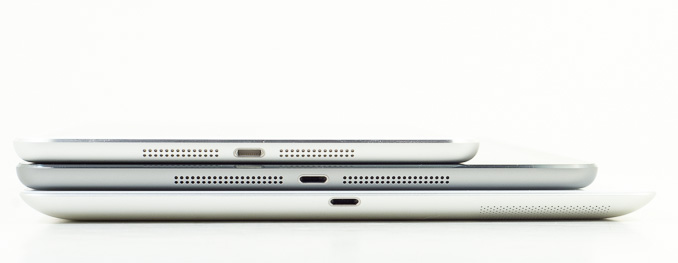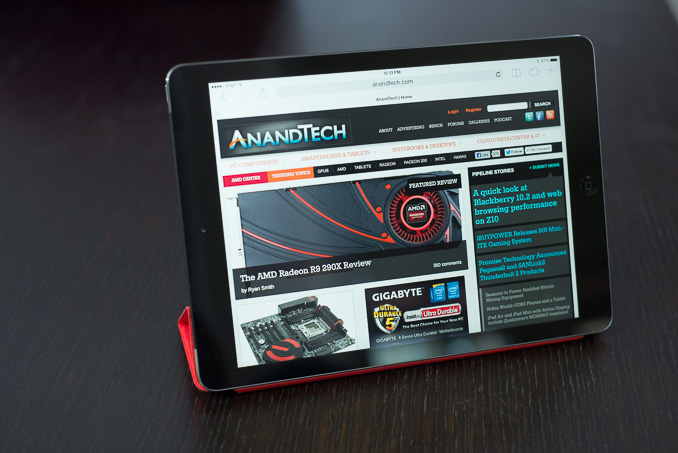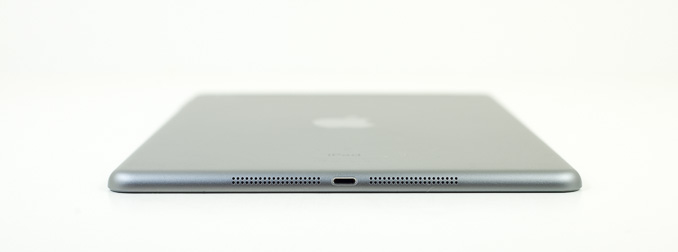The iPad Air Review
by Anand Lal Shimpi on October 29, 2013 9:00 PM ESTFinal Words
Two weeks ago I had all but written off the bigger iPad. It was too bulky and just no where near as portable as the iPad mini. Once the latter gets a Retina Display and equal hardware across the board, why would anyone consider the bigger model?
The iPad Air changed my perspective on all of that. It really does modernize the big iPad. While I suspect there are still going to be a lot of users who prefer the smaller form factor of the iPad mini with Retina Display, I do feel like there are those users who will continue to appreciate all of the benefits that go along with having a larger display. Text is easier to read, particularly on desktop versions of websites. Photos and videos are larger and thus more engaging as well. In the past there was this complex matrix of tradeoffs that you had to make between iPad and iPad mini. This generation, Apple does away with all of that.
All you need to do is pick your screen size. If you prefer the 9.7-inch form factor of the original iPad, the Air gets you as close as possible to a mini without giving up that display size.

From top to bottom: iPad mini, iPad Air, iPad 4
The name does the product justice in this case. In two hands or lightly propped up against something (palm, legs, chest), the iPad Air feels incredibly light - the weight just seems to disappear. The larger chassis doesn’t feel very dense at all. The in-hand feel of the device is really unlike any other iPad. It feels like a lightweight slate, rather than a heavy computing device. This is the iPad that Apple likely wanted to launch on day 1, it just took a bit over three years to get here.
Build and material quality are of course excellent. The iPad Air borrows much of the design language from the iPad mini, and makes the transition to a larger display quite nicely. The Air ends up looking a lot more modern than its predecessor.
Despite making the transition to a thinner touch and display stack, the iPad Air’s display is every bit as good as previous Retina Display iterations. Color accuracy remains best in class, delivering an out of box display experience that’s better than most systems, even at substantially higher price points. The only thing that the iPad Air leaves me wanting on the display front is a lower reflectance stack. Laminating the cover glass to the LCD panel is something that Apple does on both the iPhone and iMac, it’s time that the same feature is brought down to the iPad.
Apple’s decision to unify silicon across the iPhone 5s, iPad Air and iPad mini with Retina Display is an interesting one, but ultimately it doesn’t come with any real tradeoffs for iPad owners. Apple’s own 64-bit Cyclone cores are incredibly powerful, even more so than I originally expected when I reviewed the iPhone 5s. Apple seems to have built a bigger, higher performance CPU architecture than any other ARM player, including ARM itself. The design isn’t perfect, but it’s a completely different caliber performer than anything else it competes against. As such, Apple was completely justified in putting the A7 in both the iPhone 5s and the iPad Air. If anything, I’d argue that it might be overkill for the 5s given the device’s smaller battery, but my sensibilities soon get the best of me and remind me that more performance on tap is never a bad thing.
On the GPU front, Apple does increase performance over the iPad 4 as well - despite having a narrower memory bus. The increase in performance ranges from 40 - 70% depending on workload. I suspect we’re beginning to see some of the limits of 28nm here as Apple would’ve traditionally gone for an even larger GPU.
Despite having a smaller/thinner/lighter battery, battery life improves across the board compared to the 3rd and 4th generation iPads. Battery life in our web browsing, video playback and gaming workloads is better than either of the previous two iPads. Only the iPad 2,4 was able to deliver better battery life, but nothing with a Retina Display can match the iPad.
Cellular integration remains awesome on the iPad Air. With a single SKU covering 34 countries and no network operator lock, at least for those devices sold in the US, the LTE iPad Air is amazingly flexible from a network portability standpoint.
Improvements around the edges are nice as well. The inclusion of a second microphone can improve FaceTime HD calls in noisy environments, and faster WiFi is a nice addition.
My only complaints are limited to iOS 7, memory size and pricing. It’s clear that even on the fastest hardware Apple has to offer, iOS 7 isn’t always super smooth (particularly when using multitasking gestures to switch between apps) on an ultra high resolution device. The move to a 64-bit OS and applications makes a lot of sense, but with no corresponding increase in DRAM size Apple creates additional memory pressure on all of the A7 enabled devices. Finally, I’d love to see Apple update the default iPad configurations. Although 16GB is fine for a device that’s not going to be storing a ton of photos/videos locally, it would really be nice to get at least 32GB on the entry level iPad. The first complaint I suspect will be addressed over time. The second is a reality we just have to live with unfortunately, and the third won’t change until market dynamics force it to.
The iPad Air is the most significant upgrade to the 9.7-inch iPad in its history. It’s lighter, more portable, more usable and faster than any previous iPad. It doesn’t fundamentally change what you can do with a tablet, but if you’re in the market for one the iPad Air really is the best iPad to date. Competition is definitely more stiff among the smaller tablets thanks to the Nexus 7, but in the nearly 10-inch tablet space it seems like Apple is going to continue to enjoy a great position there.












444 Comments
View All Comments
Solon - Wednesday, October 30, 2013 - link
The Kindle HDX has a 1920x1200 screen, and the iPad Mini 2 has a 2048x1536 screen. So what does "pack more pixels" mean? Because it doesn't appear to mean more, you know, more pixels. And as far as the packing, the HDX is 323 ppi and the Mini 2 is 326 ppi, which is basically the same. But I guess the Mini 2 has a higher ppi, so it wins here too.Kamus - Wednesday, October 30, 2013 - link
"Pack more pixels" means just that. The Kindle Fire HDX has a 2560x1600 resolution. And it has a 339 PPI, and like the iPad, it is factory calibrated. It is, with out a doubt, a true contender for the best LCD display on a tablet.cheinonen - Wednesday, October 30, 2013 - link
The 8.9" Kindle Fire HDX has a 2560x1600 screen, not the 7". Since the 8.9" hasn't been released yet, all you know are specs on it and we have zero idea if it's calibrated or not. Once it comes out then people can take a look at it. The only numbers I've seen on the Fire HDX are that it encompasses the sRGB gamut which has absolutely nothing to do with accuracy.Morawka - Thursday, October 31, 2013 - link
yeah he shut up pretty quick after thatBob Todd - Wednesday, October 30, 2013 - link
Comparing any Kindle (or any eReader focused device) to a 'real' tablet is a complete waste of time. The software is so incredibly gimped that using them as a general use tablet is frustrating at best. And don't even start on rooting and custom ROMs. Even with stable builds of something as nice as Cyanogenmod, they tend to never work 100% (e.g. Nook HD+ with CM 10.x vs. any Nexus tab) and have a bunch of little goofy things you have to be able to accept because you bought an eReader hoping it would be an awesome cheap tablet.kmmatney - Wednesday, October 30, 2013 - link
I will second that - I have both an iPad2 and a rooted Nook HD+. The screen on the Nook HD+ is good, but Cyanogenmod still has enough bugs to degrade the overall experience. And no matter what, rooting is always a pain in the butt. I learned not to use nightly builds, as one of them bricked by device, and I had to revert back to an older build.I also Jailbroke my iPad, but there wasn't really much of a need, so just went back to stock with iOS 7. The iPad2 is just a better device than the Nook HD+, despite the lower screen resolution.
Lizbeth - Sunday, November 3, 2013 - link
adding google play to amazaon hd/hdx is fairly simple and you don't need a custom rom, just root it and install the app for the google store...Guspaz - Wednesday, October 30, 2013 - link
The Kindle is also a smaller tablet in terms of screen size, so that's not really a valid comparison... You're looking at 45.2 sqin for the iPad while only 35.6 sqin for the Kindle HDX.If you scale the iPad Air's weight by the difference in screen size, you get almost the exact same weight as the Kindle HDX (within 5 grams), indicating that a scaled down iPad Air or a scaled up Kindle HDX would match up very closely.
KoolAidMan1 - Wednesday, October 30, 2013 - link
The Kindle HDX is lighter because it is plastic, the display isn't properly calibrated like the iPad's, the hardware is much slower, and its software is limited.You get what you pay for,
Spunjji - Tuesday, November 5, 2013 - link
Everything you just said is factually inaccurate bar the software part. But don't let that stop you saying it! ;)